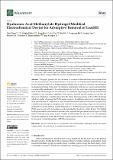| dc.contributor.author | Wang, Nan | |
| dc.contributor.author | Bora, Meghali | |
| dc.contributor.author | Hao, Song | |
| dc.contributor.author | Tao, Kai | |
| dc.contributor.author | Wu, Jin | |
| dc.contributor.author | Hu, Liangxing | |
| dc.contributor.author | Liao, Jianjun | |
| dc.contributor.author | Lin, Shiwei | |
| dc.contributor.author | Triantafyllou, Michael S. | |
| dc.contributor.author | Li, Xiaogan | |
| dc.date.accessioned | 2022-09-08T15:08:41Z | |
| dc.date.available | 2022-09-08T15:08:41Z | |
| dc.date.issued | 2022-09-02 | |
| dc.identifier.uri | https://hdl.handle.net/1721.1/145314 | |
| dc.description.abstract | This paper presents the development of a compact, three-electrode electrochemical device functionalized by a biocompatible layer of hyaluronic acid methacrylate (HAMA) hydrogel for the adsorptive removal of detrimental lead (Pb(II)) ions in aqueous solutions. An adsorption mechanism pertaining to the observed analytical performance of the device is proposed and further experimentally corroborated. It is demonstrated that both the molecular interactions originating from the HAMA hydrogel and electrochemical accumulation originating from the electrode beneath contribute to the adsorption capability of the device. Infrared spectral analysis reveals that the molecular interaction is mainly induced by the amide functional group of the HAMA hydrogel, which is capable of forming the Pb(II)–amide complex. In addition, inductively coupled plasma mass spectrometric (ICP-MS) analysis indicates that the electrochemical accumulation is particularly valuable in facilitating the adsorption rate of the device by maintaining a high ion-concentration gradient between the solution and the hydrogel layer. ICP-MS measurements show that 94.08% of Pb(II) ions present in the test solution can be adsorbed by the device within 30 min. The HAMA hydrogel-modified electrochemical devices exhibit reproducible performance in the aspect of Pb(II) removal from tap water, with a relative standard deviation (RSD) of 1.28% (for <i>n</i> = 8). The experimental results suggest that the HAMA hydrogel-modified electrochemical device can potentially be used for the rapid, on-field remediation of Pb(II) contamination. | en_US |
| dc.publisher | Multidisciplinary Digital Publishing Institute | en_US |
| dc.relation.isversionof | http://dx.doi.org/10.3390/bios12090714 | en_US |
| dc.rights | Creative Commons Attribution | en_US |
| dc.rights.uri | https://creativecommons.org/licenses/by/4.0/ | en_US |
| dc.source | Multidisciplinary Digital Publishing Institute | en_US |
| dc.title | Hyaluronic Acid Methacrylate Hydrogel-Modified Electrochemical Device for Adsorptive Removal of Lead(II) | en_US |
| dc.type | Article | en_US |
| dc.identifier.citation | Biosensors 12 (9): 714 (2022) | en_US |
| dc.contributor.department | Singapore-MIT Alliance in Research and Technology (SMART) | |
| dc.contributor.department | Massachusetts Institute of Technology. Department of Mechanical Engineering | |
| dc.identifier.mitlicense | PUBLISHER_CC | |
| dc.eprint.version | Final published version | en_US |
| dc.type.uri | http://purl.org/eprint/type/JournalArticle | en_US |
| eprint.status | http://purl.org/eprint/status/PeerReviewed | en_US |
| dc.date.updated | 2022-09-08T13:24:12Z | |
| dspace.date.submission | 2022-09-08T13:24:12Z | |
| mit.license | PUBLISHER_CC | |
| mit.metadata.status | Authority Work and Publication Information Needed | en_US |
